Filtered Influence Function of Deformable Mirror for Wavefront Correction in Laser Systems
Abstract
1. Introduction
2. Principles
2.1. Principles of the Wavefront Correction Analysis Model
2.2. Principles of IFFM
3. Simulation
4. Experiment
5. Discussion
6. Conclusions
Author Contributions
Funding
Data Availability Statement
Acknowledgments
Conflicts of Interest
References
- Zhang, X.; Arcidiacono, C.; Conrad, A.R.; Herbst, T.M.; Gaessler, W.; Bertram, T.; Ragazzoni, T.; Schreber, L.; Diolaiti, E.; Kuerster, M.; et al. Calibrating the interaction matrix for the LINC-NIRVANA high layer wavefront sensor. Opt. Express 2012, 20, 8078–8092. [Google Scholar] [CrossRef] [PubMed]
- Lardiere, O.; Conan, R.; Bradley, C.; Jackson, K.; Herriot, G. A laser guide star wavefront sensor bench demonstrator for TMT. Opt. Express 2008, 16, 5527–5543. [Google Scholar] [CrossRef] [PubMed]
- Baranec, C.; Lloyd -Hart, M.; Milton, N.M.; Stalcup, T.; Snyder, M.; Vaitheeswaran, V.; McCarthy, D.; Angel, R. Astronomical imaging using ground-layer adaptive optics. Proc. SPIE 2007, 6691, 66910N. [Google Scholar] [CrossRef]
- Van Dam, M.A.; Bouchez, A.H.; Le Mignant, D.; Johansson, E.M.; Wizinowich, P.L.; Campbell, R.D.; Chin, J.C.Y.; Hartman, S.K.; Lafon, R.E.; Stomski, J.P.J.; et al. The W. M. Keck Observatory Laser Guide Star Adaptive Optics System: Performance Characterization. Publ. Astron. Soc. Pac. 2006, 118, 310–318. [Google Scholar] [CrossRef]
- Esposito, S.; Riccardi, A.; Fini, L.; Puglisi, A.T.; Pinna, E.; Xompero, M.; Briguglio, R.; Quirós-Pacheco, F.; Stefanini, P.; Guerra, J.C.; et al. First light AO (FLAO) system for LBT: Final integration, acceptance test in Europe, and preliminary on-sky commissioning results. Proc. SPIE 2010, 7736, 773609. [Google Scholar] [CrossRef]
- Martinache, F.; Guyon, O.; Clergeon, C.; Garrel, V.; Blain, C. The Subaru coronagraphic extreme AO project: First observations. Proc. SPIE 2012, 8447, 84471Y. [Google Scholar] [CrossRef]
- Neichel, B.; Rigaut, F.; Vidal, F.; van Dam, M.A.; Garrel, V.; Carrasco, E.R.; Pessev, P.; Winge, C.; Boccas, M.; d’Orgeville, C.; et al. Gemini multiconjugate adaptive optics system review—II. Commissioning, operation and overall performance. Mon. Not. R. Astron. Soc. 2014, 440, 1002–1019. [Google Scholar] [CrossRef]
- Sauvage, J.; Fusco, T.; Petit, C.; Costille, A.; Mouillet, D.; Beuzit, J.; Dohlen, K.; Kasper, M.; Suarez, M.; Soenke, C.; et al. SAXO: The extreme adaptive optics system ofSPHERE (I) system overview and global laboratory performance. J. Astron. Telesc. Instrum. Syst. 2016, 2, 025003. [Google Scholar] [CrossRef]
- Rahman, S.A.; Booth, M.J. Direct wavefront sensing in adaptive optical microscopy using backscattered light. Appl. Opt. 2013, 52, 5523–5532. [Google Scholar] [CrossRef]
- Bonora, S.; Jian, Y.F.; Zhang, P.F.; Zam, A.; Pugh, E.N.; Zawadzki, R.J.; Sarunic, M.V. Wavefront correction and high-resolution in vivo OCT imaging with an objective integrated multi-actuator adaptive lens. Opt. Express 2015, 23, 21931–21941. [Google Scholar] [CrossRef]
- Sahu, P.; Mazumder, N. Advances in adaptive optics–based two-photon fluorescence microscopy for brain imaging. Lasers Med. Sci. 2020, 35, 317–328. [Google Scholar] [CrossRef] [PubMed]
- Zacharias, R.A.; Beer, N.R.; Bliss, E.S.; Burkhar, S.C.; Cohen, S.J.; Sutton, S.B.; Van Atta, R.L.; Winters, S.E.; Salmon, J.T.; Stolz, C.J.; et al. National Ignition Facility alignment and wavefront control. Proc. SPIE 2004, 5341, 168–179. [Google Scholar] [CrossRef]
- Sacks, R.; Auerbach, J.; Bliss, E.; Henesian, M.; Lawson, J.; Manes, K.; Renard, P.; Salmon, T.; Trenholme, J.; Williams, W.; et al. Application of adaptive optics for controlling the NIF laser performance and spot size. Proc. SPIE 1999, 3492, 344–354. [Google Scholar] [CrossRef]
- Van Wonterghem, B.M.; Murray, J.R.; Campbell, J.H.; Speck, D.R.; Barker, C.E.; Smith, I.C.; Browning, D.F.; Behrendt, W.C. Performance of a prototype for a large-aperture multipass Nd:glass laser for inertial confinement fusion. Appl. Opt. 1997, 36, 4932–4953. [Google Scholar] [CrossRef]
- Hammer, D.X.; Ferguson, R.D.; Bigelow, C.E.; Iftimia, N.V.; Ustun, T.E.; Burns, S.A. Adaptive optics scanning laser ophthalmoscope for stabilized retinal imaging. Opt. Express 2006, 14, 3354–3367. [Google Scholar] [CrossRef]
- Fernandez, E.J.; Vabre, L.; Hermann, B.; Unterhuber, A.; Povazay, B.; Drexler, W. Adaptive optics with a magnetic deformable mirror: Applications in the human eye. Opt. Express 2006, 14, 8900–8917. [Google Scholar] [CrossRef]
- Marcos, S.; Werner, J.S.; Burns, S.A.; Merigan, W.H.; Artal, P.; Atchison, D.A.; Hampson, K.M.; Legras, R.; Lundstrom, L.; Yoon, G.; et al. Vision science and adaptive optics, the state of the field. Vision Res. 2017, 132, 3–33. [Google Scholar] [CrossRef]
- Goodno, G.D.; Komine, H.; McNaught, S.J.; Weiss, S.B.; Redmond, S.; Long, W.; Simpson, R.; Cheung, E.C.; Howland, D.; Epp, P.; et al. Coherent combination of high-power, zigzag slab lasers. Opt. Lett. 2006, 31, 1247–1249. [Google Scholar] [CrossRef]
- Sun, L.C.; Guo, Y.D.; Shao, C.F.; Li, Y.; Zheng, Y.M.; Sun, C.; Wang, X.J.; Huang, L. 10.8 kW, 2.6 times diffraction limited laser based on a continuous wave Nd:YAG oscillator and an extra-cavity adaptive optics system. Opt. Lett. 2018, 43, 4160–4163. [Google Scholar] [CrossRef]
- Xu, L.; Wu, Y.C.; Du, Y.L.; Wang, D.; An, X.C.; Li, M.; Zhou, T.J.; Shang, J.L.; Wang, J.T.; Liu, Z.W.; et al. High brightness laser based on Yb:YAG MOPA chain and adaptive optics system at room temperature. Opt. Express 2018, 26, 14592–14600. [Google Scholar] [CrossRef]
- Brousseau, D.; Borra, E.F.; Thibault, S. Wavefront correction with a 37-actuator ferrofluid deformable mirror. Opt. Express 2007, 15, 18190–18199. [Google Scholar] [CrossRef]
- Bonora, S. Distributed actuators deformable mirror for adaptive optics. Opt. Commun. 2011, 284, 3467–3473. [Google Scholar] [CrossRef]
- Gonzalez-Nunez, H.; Bechet, C.; Ayancan, B.; Neichel, B.; Guesalaga, A. Effect of the influence function of deformable mirrors on laser beam shaping. Appl. Opt. 2017, 56, 1637–1646. [Google Scholar] [CrossRef]
- Fernandez, E.J.; Artal, P. Membrane deformable mirror for adaptive optics: Performance limits in visual optics. Opt. Express 2003, 11, 1056–1069. [Google Scholar] [CrossRef] [PubMed]
- Mansell, J.; Jameson, J.; Henderson, B. Advanced deformable mirrors for high-power lasers. Proc. SPIE 2014, 9083, 90830O. [Google Scholar] [CrossRef]
- Zou, W.Y.; Burns, S.A. High-accuracy wavefront control for retinal imaging with Adaptive-Influence-Matrix Adaptive Optics. Opt. Express 2009, 17, 20167–20177. [Google Scholar] [CrossRef] [PubMed]
- Huang, L.; Ma, X.K.; Bian, Q.; Li, T.H.; Zhou, C.L.; Gong, M.L. High-precision system identification method for a deformable mirror in wavefront control. Appl. Opt. 2015, 54, 4313–4317. [Google Scholar] [CrossRef]
- Ren, Z.L.; Liu, J.; Zhang, Z.T.; Chen, Z.T.; Liang, Y.H. High-resolution wavefront reconstruction using multiframe Shack–Hartmann wavefront sensor measurements. Opt. Eng. 2020, 59, 113102. [Google Scholar] [CrossRef]
- Zheng, Y.M.; Sun, C.; Dai, W.J.; Zeng, F.; Xue, Q.; Wang, D.E.; Zhao, W.C.; Huang, L. High precision wavefront correction using an influence function optimization method based on a hybrid adaptive optics system. Opt. Express 2019, 27, 34937–34951. [Google Scholar] [CrossRef]
- Huang, L.H.; Rao, C.H.; Jiang, W.H. Modified Gaussian influence function of deformable mirror actuators. Opt. Express 2008, 16, 108–114. [Google Scholar] [CrossRef]
- Roopashree, M.B.; Vyas, A.; Prasad, B.R. Influence Function Measurement of Continuous Membrane Deformable Mirror Actuators Using Shack Hartmann Sensor. AIP Conf. Proc. 2011, 1391, 453–455. [Google Scholar] [CrossRef]
- Rosen, S.; Eldert, C. Least-Squares Method for Optical Correction. J. Opt. Soc. Am. 1954, 44, 250–252. [Google Scholar] [CrossRef]
- Claflin, E.S.; Bareket, N. Configuring an electrostatic membrane mirror by least-squares fitting with analytically derived influence functions. J. Opt. Soc. Am. 1986, 3, 1833–1839. [Google Scholar] [CrossRef]
- Feng, Z.X.; Huang, L. Over compensation algorithm for laser beam shaping using a deformable freeform mirror. Optik 2019, 198, 163250. [Google Scholar] [CrossRef]
- Tabatabaian, M. COMSOL for Engineers; Mercury Learning & Information: Herndon, VA, USA, 2014. [Google Scholar]
- Higham, D.J.; Higham, N.J. MATLAB Guide, 3rd ed.; Siam: Philadelphia, PA, USA, 2016. [Google Scholar]
- Wang, J.Y.; Silva, D.E. Wave-front interpretation with Zernike polynomials. Appl. Opt. 1980, 19, 1510–1518. [Google Scholar] [CrossRef] [PubMed]
- Alda, J.; Boreman, G.D. Zernike-based matrix model of deformable mirrors: Optimization of aperture size. Appl. Opt. 1993, 32, 2431–2438. [Google Scholar] [CrossRef][Green Version]


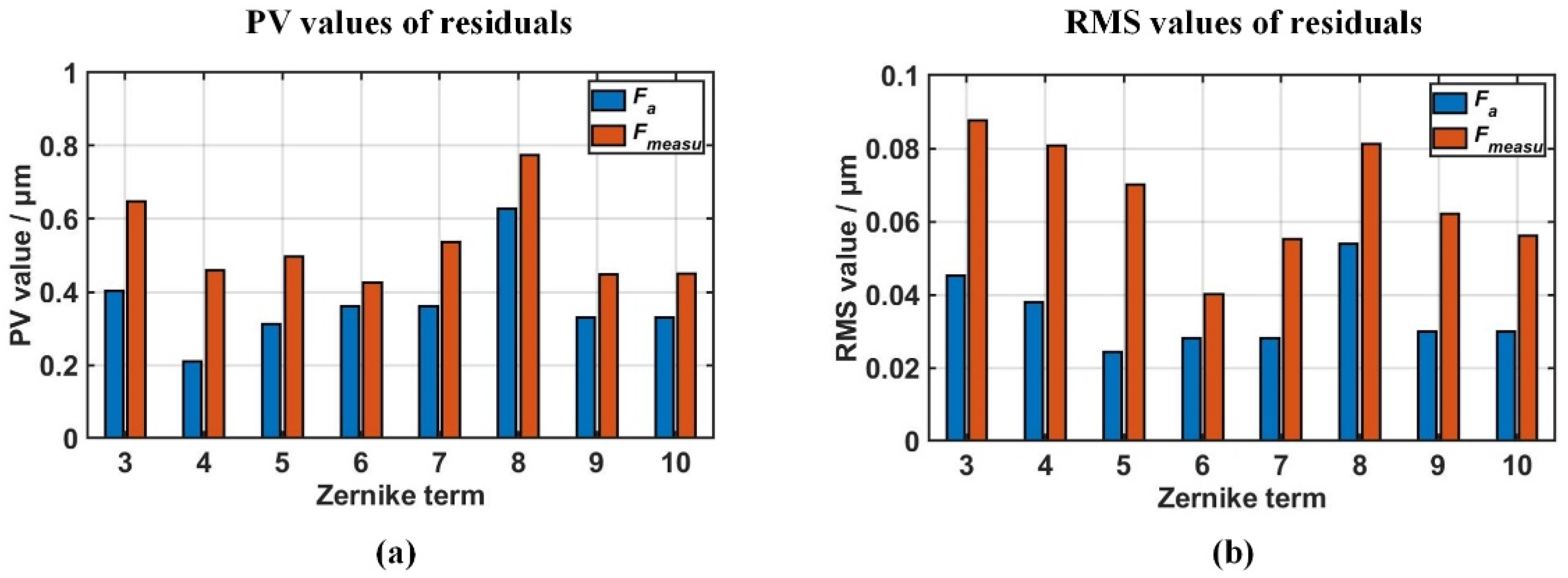



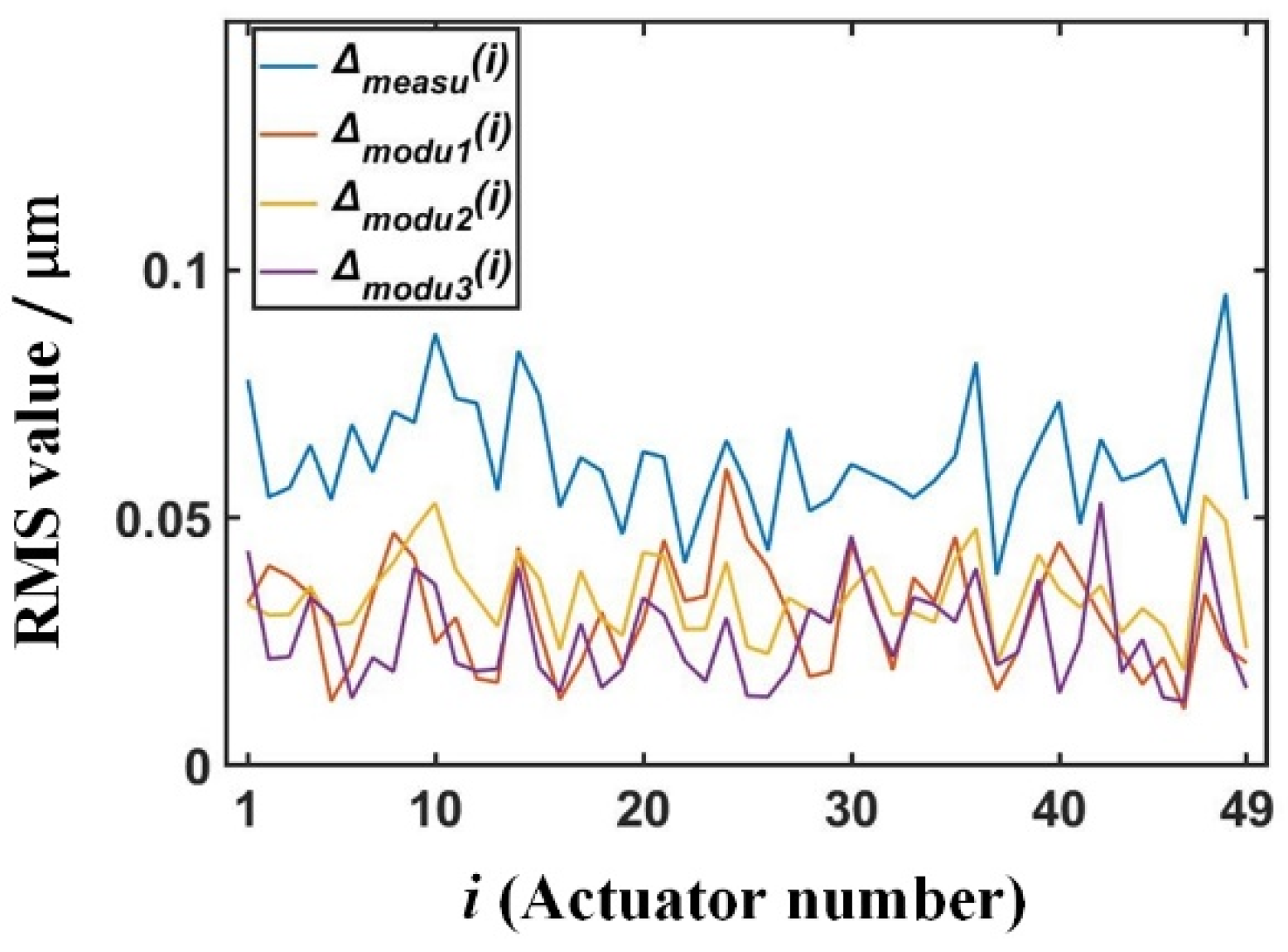
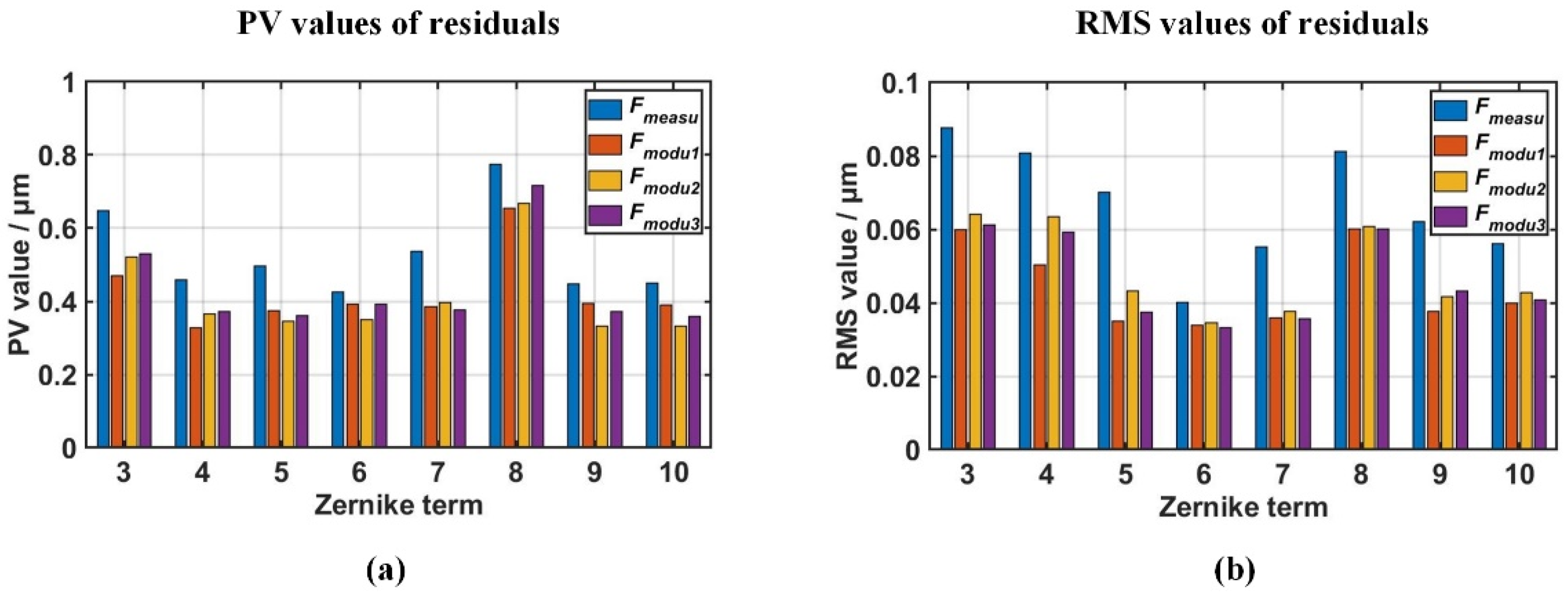
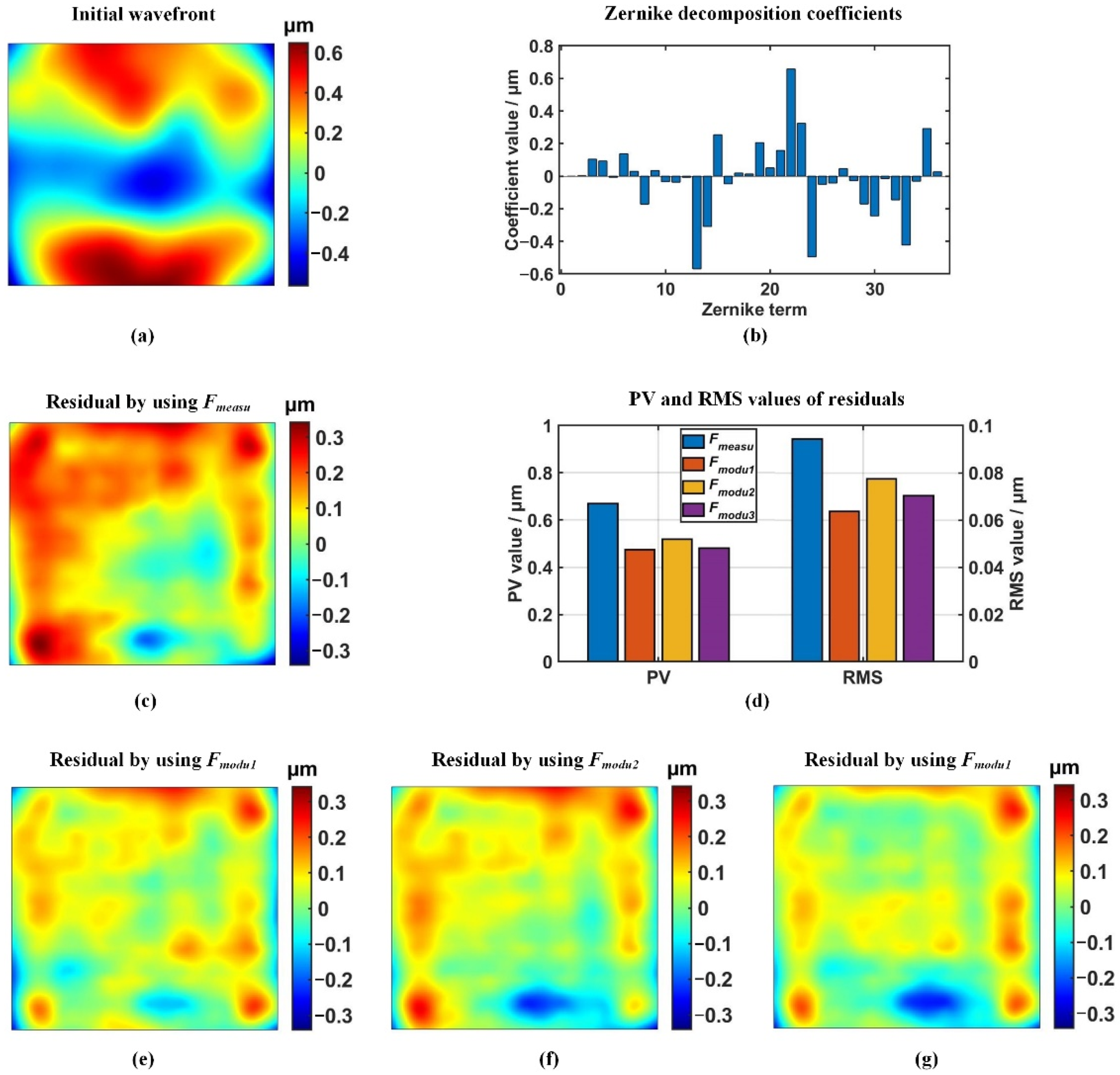

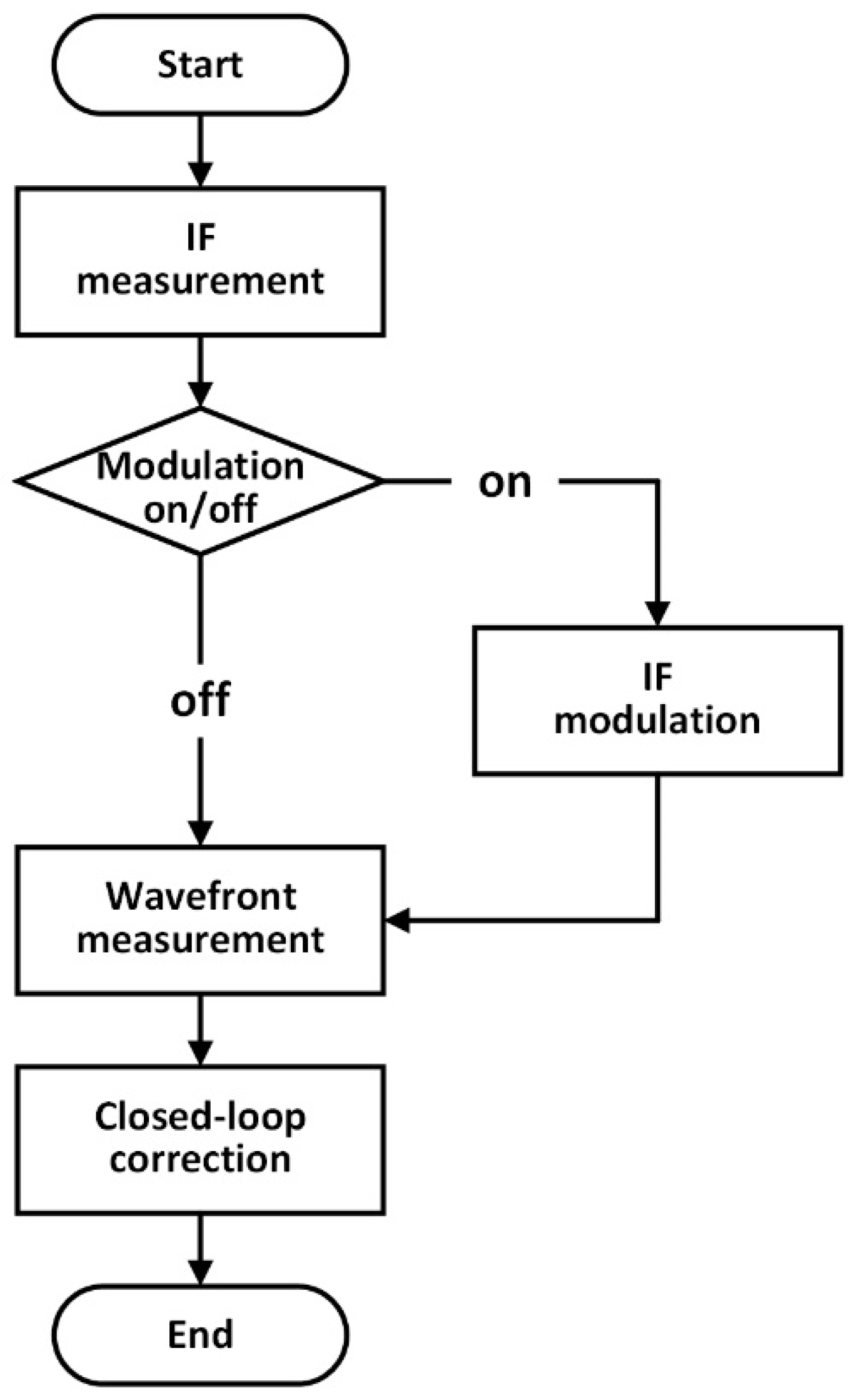
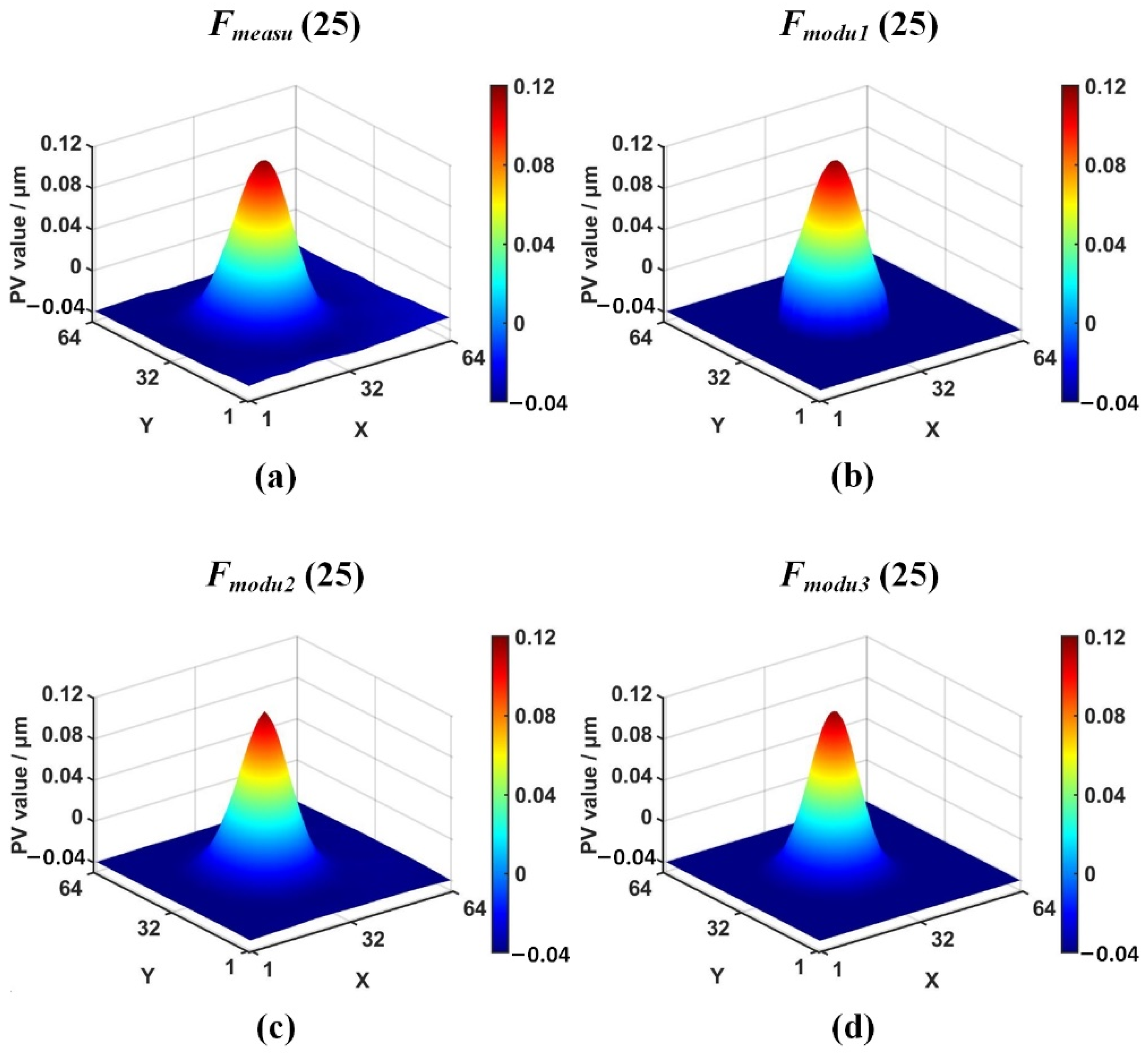

| Symbol | Description |
|---|---|
| Initial wavefront before correction | |
| Residual wavefront after correction | |
| Control signal of the DM | |
| Simulated ideal IF of the DM | |
| Measured IF of the DM | |
| Filtered IF of the DM | |
| Measurement noise of the IF |
| Parameter | Mirror | Actuator | Base |
|---|---|---|---|
| Value/mm | 84 84 2 | 5 30 | 84 84 40 |
| Parameter | BK7 | Stainless Steel | Piezoelectric Ceramics |
|---|---|---|---|
| Young’s Modulus/GPa | 81 | 193 | 75 |
| Poisson’s Ratio | 0.17 | 0.3 | 0.35 |
| Density/kgm−3 | 2400 | 7930 | 7750 |
| Linear Expansivity/10−6K−1 | 7.1 | 17.2 | 12 |
Publisher’s Note: MDPI stays neutral with regard to jurisdictional claims in published maps and institutional affiliations. |
© 2021 by the authors. Licensee MDPI, Basel, Switzerland. This article is an open access article distributed under the terms and conditions of the Creative Commons Attribution (CC BY) license (https://creativecommons.org/licenses/by/4.0/).
Share and Cite
Zheng, Y.; Lei, M.; Lin, S.; Wang, D.; Xue, Q.; Huang, L. Filtered Influence Function of Deformable Mirror for Wavefront Correction in Laser Systems. Photonics 2021, 8, 410. https://doi.org/10.3390/photonics8100410
Zheng Y, Lei M, Lin S, Wang D, Xue Q, Huang L. Filtered Influence Function of Deformable Mirror for Wavefront Correction in Laser Systems. Photonics. 2021; 8(10):410. https://doi.org/10.3390/photonics8100410
Chicago/Turabian StyleZheng, Yamin, Ming Lei, Shibing Lin, Deen Wang, Qiao Xue, and Lei Huang. 2021. "Filtered Influence Function of Deformable Mirror for Wavefront Correction in Laser Systems" Photonics 8, no. 10: 410. https://doi.org/10.3390/photonics8100410
APA StyleZheng, Y., Lei, M., Lin, S., Wang, D., Xue, Q., & Huang, L. (2021). Filtered Influence Function of Deformable Mirror for Wavefront Correction in Laser Systems. Photonics, 8(10), 410. https://doi.org/10.3390/photonics8100410






